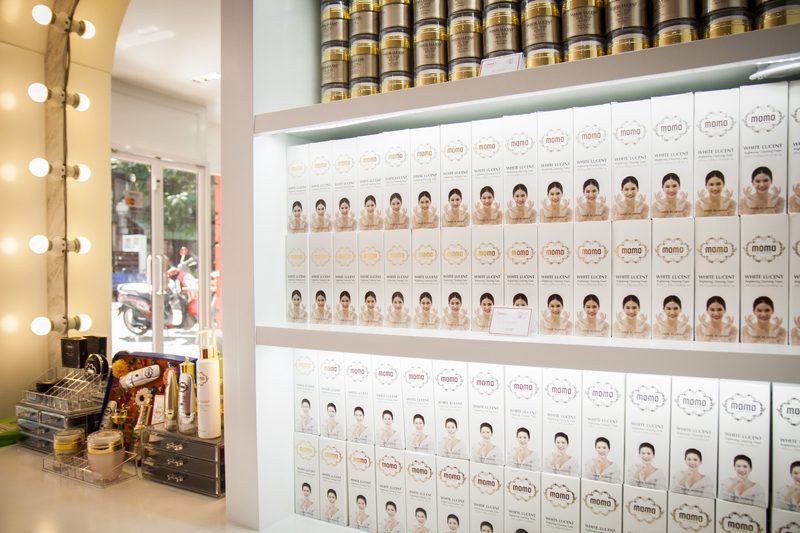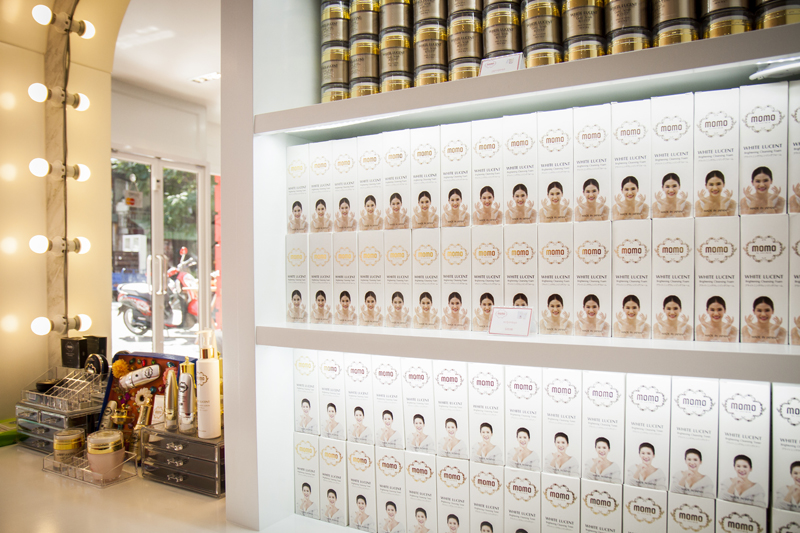Standing in her small beauty salon in the narrow corridors of Phnom Penh’s Phsar Kabko, Srey Mao taps on her smartphone as she explains, step-by-step, her $30 skin-whitening treatment.
“First, I put on the cream and leave [it] for two hours,” she says. “Then I wash off and pat the skin dry. Over the next three days, the skin peels off and it becomes whiter, which is when it is most painful and itchy.”

At her busiest, Ms. Mao applies her skin-whitening creams on 30 women per month; male clients prefer to use the cream at home. Asked why this painful, time-consuming treatment was so popular, her response is unequivocal. “Whiter skin is more attractive.”
Ms. Mao’s belief is shared by many. The desire for fairer skin goes far beyond the borders of Cambodia and underpins a thriving global industry. Worldwide, the market for skin lightening cosmetics is predicted to grow to $23 billion by 2020, according to a study published last year by market research firm Global Industry Analysts.
Growth is predicted to be particularly strong in the Asia-Pacific region, with revenue projected to increase at a rate of 11.2 percent per year.
In Cambodia, the use of skin-whitening creams has been shown to carry significant risk as they often contain toxic compounds, predominantly mercury, but also lead, arsenic and salicylic acid, which can burn the skin in too-high concentrations and lead to Reye’s syndrome, a condition that causes, among other symptoms, swelling of the liver and brain.
A study published last year in the U.S.-based Journal of Health & Pollution found that in Cambodia, “there is widespread use of skin-whitening creams containing levels of mercury that exceed…ASEAN guidelines by up to 35,000 times.”
Many creams are produced locally—often by vendors who then refill empty brand-name packaging with their own concoctions—or imported from Thailand and Vietnam, the study says.
Thomas Murphy, the study’s lead researcher and a retired government scientist from Canada, said about 1 in 5 skin-whitening creams sold in Cambodia are contaminated with mercury, a statistic common to the rest of Southeast Asia.
“It’s a common level of contamination,” Mr. Murphy said. “This is a regional problem.”
The ASEAN guideline for mercury content in cosmetics is 1 microgram per gram. When levels reach 1,000 micrograms per gram, 27 percent of people using the cream report outbreaks of dermatitis, according to the study. Continued application of mercury-contaminated creams can lead to “kidney damage…neurological toxicity and skin disorders,” it notes.
In an email, Mr. Murphy outlined two deaths in 2011 connected to the Vietnamese skin-whitening cream Bao Dam, which he said likely contained too much salicylic acid. Yet, he wrote, “in 2015, we were able to buy Bao Dam creams in markets in Phnom Penh that still contained salicylic acid with more than five times the allowed level.”
One person at risk of buying such a cream is Sovann, a 23-year-old from Phnom Penh who did not give his full name because he did not want people to know he used skin whitening products. While still a fraction of the total market, the Asian market for male cosmetics is predicted to be worth $2.16 billion this year.
“I buy five or six different creams from the market and then mix them all together,” Sovann said. “I apply the mixture to my face every night, or five times a week if I am busy.”
He said his whitening routine had caused his skin to become irritated, itchy and sensitive to sunlight, something he remedied by applying sunscreen each morning.
Informed of studies that have linked a heightened presence of mercury in men to a loss of fertility, Sovann replied, “I am aware of the risks, but it works and makes me look more handsome.”
Cultural Pressure
Historically, skin tone and social status have been intertwined in Cambodia, one of the reasons why many in the country use skin-whitening creams today, said Saphon Somolireasmey, a doctor and the director of the philosophy master’s program at the Royal University of Phnom Penh.
The Khmer term “khmeng sre,” or ”countryside child,” is a commonly used pejorative associated with poverty, darker skin and laboring outdoors in the sun, she said.
“The phrase…insinuates an ugly appearance and inferior social status, whereas white skin is considered as a sign of beauty and wealth,” she wrote in an email.
Dr. Somolireasmey also noted the centuries-old Cambodian tradition of “chol mlub,” or “entering shade,” a historical rite of passage for girls. Upon entering puberty, they were once locked in the house, out of the sunlight, possibly for months at a time, and taught the skills required to be a good wife. One of these skills was how to keep their skin light.
“Women are expected to have smooth, tender and yellow skin (bright skin) when they apply turmeric powder and some other traditional medicines on their skin,” Dr. Somolireasmey wrote, referencing the old practices. “The length of Chol Mlob could last anywhere from three to six months, depending on family class.”
Chul mlob is practiced little, if at all, today. But the underlying ethos that whiter skin is synonymous with higher social status and beauty has survived, and is now reinforced by television, social media and advertising, she wrote.
Images “promote the ideal beauty of women as being slim, tall, and white,” she said.
While many skin-whitening treatments in Cambodia are home-grown, the desire for whiter skin has not been overlooked by Western cosmetics manufacturers.
Beiersdorf, a German company that owns the Nivea skincare brand, sells a range of face washes, moisturisers and deodorants in Cambodia, all promising a skin-whitening effect.
When asked if whitening messaging on their products supported cultural beliefs that whiter skin is more socially attractive Beiersdorf claimed that their products were aimed at giving men and women confidence in their own skin.
“Beauty in Asia is connected to a pale complexion, which is associated with youth,” a company representative wrote in an email. “Our messages are geared towards giving the consumer confidence to be the best themselves and feel at ease in their skin.”
Thida Khus, a prominent women’s rights activist in Cambodia, said that such comments were both misleading and unethical.
“It isn’t associated with youth, it is about beauty,” she said. “These companies like Nivea who are coming to Cambodia, they know the country; they are aware of the market research.”
“I think it is just so inhumane to get somebody to change their skin color to suit somebody’s role and standard,” she said.
Pressure from advertising—not just from Beiersdorf, but from many other foreign and domestic companies—has created an environment that drives people, often with low income, to the markets where more dangerous whitening products abound, Ms. Khus said.
Bootlegging and Regulation
The main challenge in tackling the spread of potentially dangerous skin-whitening creams is widespread bootlegging and lax regulatory controls, said Mr. Murphy, the researcher.
In Phnom Penh’s Phsar Thmei, a vendor said she made her own skin-whitening cream by importing a base product from Thailand and then adding her own “ingredients” to the mix.
Asked how she could guarantee the safety of her cream, and whether it was certified by the Health Ministry, her demeanor turned frosty.
“I have been doing this for seven years. I learned in Thailand,” she said, declining to give her name. “I only make small amounts, so I don’t need to tell the Health Ministry. I know what I am doing.”
Ly Sovann, the Health Ministry’s spokesman, said he did not know what the current certification and regulatory process was for cosmetics, referring questions to Heng Bun, director of cosmetics at the ministry’s department of drugs and food.
Dr. Heng did not know either, and referred questions to an employee he named only as Sivouch, who said that all companies had to “follow Asean guidelines,” without elaborating.
Srei Pisei Huong, a lecturer and researcher of cosmetology at the University of Health Sciences in Phnom Penh, said there were no special rules governing the sale of cosmetic whitening creams in Cambodia.
“All the cosmetics product selling in Cambodia needs to have a registration number from ministry of health,” she wrote in an email. “To get the registration number for any cosmetic product, you need to provide the product’s sample, and the product’s technical documents (such as product composition…) to the department of drugs and food.”
Asked if there were any ongoing checks or regulation, she replied, “I don’t know about that.”
Mr. Murphy said that in his experience, ongoing quality control was almost nonexistent.
“As far as I am aware, there is no ongoing testing here,” he said. “They do monitor mercury, but not often.”
Mr. Murphy said more could be done by the government, while acknowledging that manufacturers and dealers likely would find workarounds to keep costs down and their products on market shelves.
“The vendors aren’t stupid. They will just be more careful if there was a ban,” he said. “I am more interested in the education aspect. People need to know what is in these creams.”
Ms. Khus, the rights activist, said that cultural pressure and a lack of knowledge about the dangers of skin-whitening creams was the ultimate crux of the problem.
“The government needs to be doing more,” she said.
However, for Ms. Mao, the market vendor, the issue was about profits.
“I have heard about the risks,” she said. “But if people want to do it, then it is good for business.”




